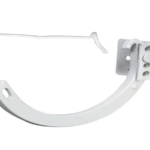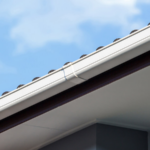Residential gutters come in a variety of sizes, the most common being 5 inches wide. Other sizes include 6 inches, 7 inches, and 8 inches. The size of the gutter you need depends on the size of your home and the amount of rainfall you typically receive.
Should I use 5 or 6 inch gutters?
The answer to this question depends on a few factors. The size of your house, the amount of rainfall in your area, and your personal preference are all important considerations.
If you live in an area with a lot of rainfall, you may want to consider using 6 inch gutters. This will help to ensure that your gutters don’t overflow and cause water damage to your home.
If you have a small home, you may be able to get away with using 5 inch gutters. However, if you are unsure, it is always better to err on the side of caution and go with the larger size.
Ultimately, the decision of which size to use is up to you. Consider all of the factors involved and make the choice that you feel is best for your home.
Do 6 inch gutters make a difference?
If you want to keep your home in tiptop shape, then you need to pay attention to your gutters. All gutters, regardless of size, play an important role in protecting your home from water damage. However, when it comes to gutters, size does matter. Here’s a look at why 6 inch gutters make a difference.
The most important function of gutters is to channel water away from your home. This is especially important during heavy rains when there is a risk of water seeping into your home and causing damage. The larger the gutters, the more water they can channel away from your home. This means that 6 inch gutters are better able to protect your home from water damage than smaller gutters.
In addition to channeling water away from your home, gutters also help to protect your foundation. When water seeps into the ground around your foundation, it can cause the foundation to shift and crack. This can lead to serious structural problems with your home. By channeling water away from your foundation, gutters help to prevent these problems.
What are the standard sizes of gutters and downspouts?
The standard size for a gutter is five inches wide and a downspout is two and a half inches wide. Most gutters are white, but they can be found in a variety of colors to match the trim on your house.
Do larger gutters clog less?
The quick answer is no, but there are a few factors to consider.
Gutters of all sizes can clog for a variety of reasons. Falling leaves and twigs are the most common culprits, but gutters can also clog with dirt, sand, and other debris. Larger gutters may be less likely to clog because they can hold more debris before they need to be cleaned out. However, this is not always the case. Some larger gutters may have more difficulty draining if they are installed on a slope or if the downspouts are not properly installed.
How much water can 6-inch gutters hold?
The average 6-inch gutters can hold around 10 gallons of water per linear foot. This means that a 20-foot gutter system can hold around 200 gallons of water. However, the gutters must be properly maintained in order to prevent them from becoming overloaded and spilling water onto the ground.
It is important to regularly clean your gutters to ensure that they are able to function properly. Leaves, twigs, and other debris can easily build up and clog the gutters, preventing water from flowing through them. If the gutters are not cleaned on a regular basis, they can become overloaded and cause water to spill onto the ground.
In order to prevent your gutters from becoming overloaded, it is important to ensure that they are properly sized for your home. If you live in an area with a lot of rainfall, you may need to install larger gutters or additional downspouts to handle the increased amount of water.
What is the price difference between 5-inch and 6-inch gutters?
The price difference between 5-inch and 6-inch gutters is about $2 per foot. The 5-inch gutters are less expensive because they are smaller and require less material. The 6-inch gutters are more expensive because they are larger and require more material.
Are 5-inch gutters sufficient?
There is no definitive answer to this question as it depends on a number of factors, such as the size and type of your home, the climate you live in, and the amount of rainfall you typically experience. However, in general, 5-inch gutters are sufficient for most homes. If you live in an area with high amounts of rainfall, or if your home is particularly large or has many stories, you may need to upgrade to 6-inch gutters.
What is the cost difference between 5 and 6-inch gutters?
There is a significant cost difference between 5 and 6-inch gutters. The larger the gutters, the more they will cost. The main reason for this is because the larger the gutters, the more material is required to make them. This means that the labor costs will also be higher. In addition, the larger the gutters, the more they will weigh. This can make them more difficult to install, which will also add to the cost.
Are 6-inch gutters too big?
There is no definitive answer to this question, as the size of gutters that will work best for your home depends on a variety of factors. Some of the things that you’ll need to take into account include the size and slope of your roof, the amount of rainfall your area receives, and the number of trees near your home. With that said, many experts believe that 6-inch gutters are often the best option, as they can handle a large amount of water and are less likely to get clogged than smaller gutters.
Final Word
The most common size for residential gutters is five inches. However, six and seven-inch gutters are also becoming increasingly popular. The size of your gutters will ultimately depend on the size and slope of your roof.
















